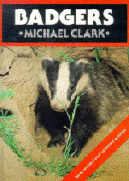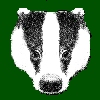Carnivora

 If
you were to make a quick examination of the badger's skull and teeth, you might
be mistaken into thinking it was "designed" to kill other animals, eat meat and
nothing else. However, assuming badgers are solely carnivores is a common mistake.
Whilst they do have carnivore-type teeth at the front, they also have powerful
molar/cheek teeth at the back - these being good for grinding tough foods, like
root vegetables and nuts. If
you were to make a quick examination of the badger's skull and teeth, you might
be mistaken into thinking it was "designed" to kill other animals, eat meat and
nothing else. However, assuming badgers are solely carnivores is a common mistake.
Whilst they do have carnivore-type teeth at the front, they also have powerful
molar/cheek teeth at the back - these being good for grinding tough foods, like
root vegetables and nuts.
Therefore, although the badger is technically a carnivore (it belongs to the
zoological order of animals classed as Carnivora), in fact their diet is actually
omnivorous - that is, it eats all sorts of
plant and animal foods. The guts of badgers
are longer than those of foxes, reflecting their omnivorous diet. In badgers,
the small intestine has a mean length of 5.36 metres (17.6 ft). The small
intestine is the part between the stomach and the large intestine; and is where
most of the end absorption of food takes place.
The
main types of food eaten are listed on the left-hand
menu.
The broad and varied nature of their diet certainly helps badgers
survive over the winter when food is scarce.
People are sometimes surprised (or even shocked) to find that badgers
will eat things such as cat food and dog food, as well as food dropped
by people who have visited take-away caterers and food bins near
commercial food businesses. In rare circumstances, it has even been known for badgers to come
into dwellings through cat flaps; and eat cat food and dog food inside
people's kitchens. For example:
http://www.bbc.co.uk/news/uk-scotland-edinburgh-east-fife-41683405 Badgers
can very easily sniff out meat-based smells and will quickly know that meaty
food has been left in the area.
| Michael Clark
book |
 |
This is a superb book about badgers by Michael
Clark. His immense knowledge of badgers really shines through. Click here to buy:
2017 edition or
2010 edition
or
2010 edition
|
|
